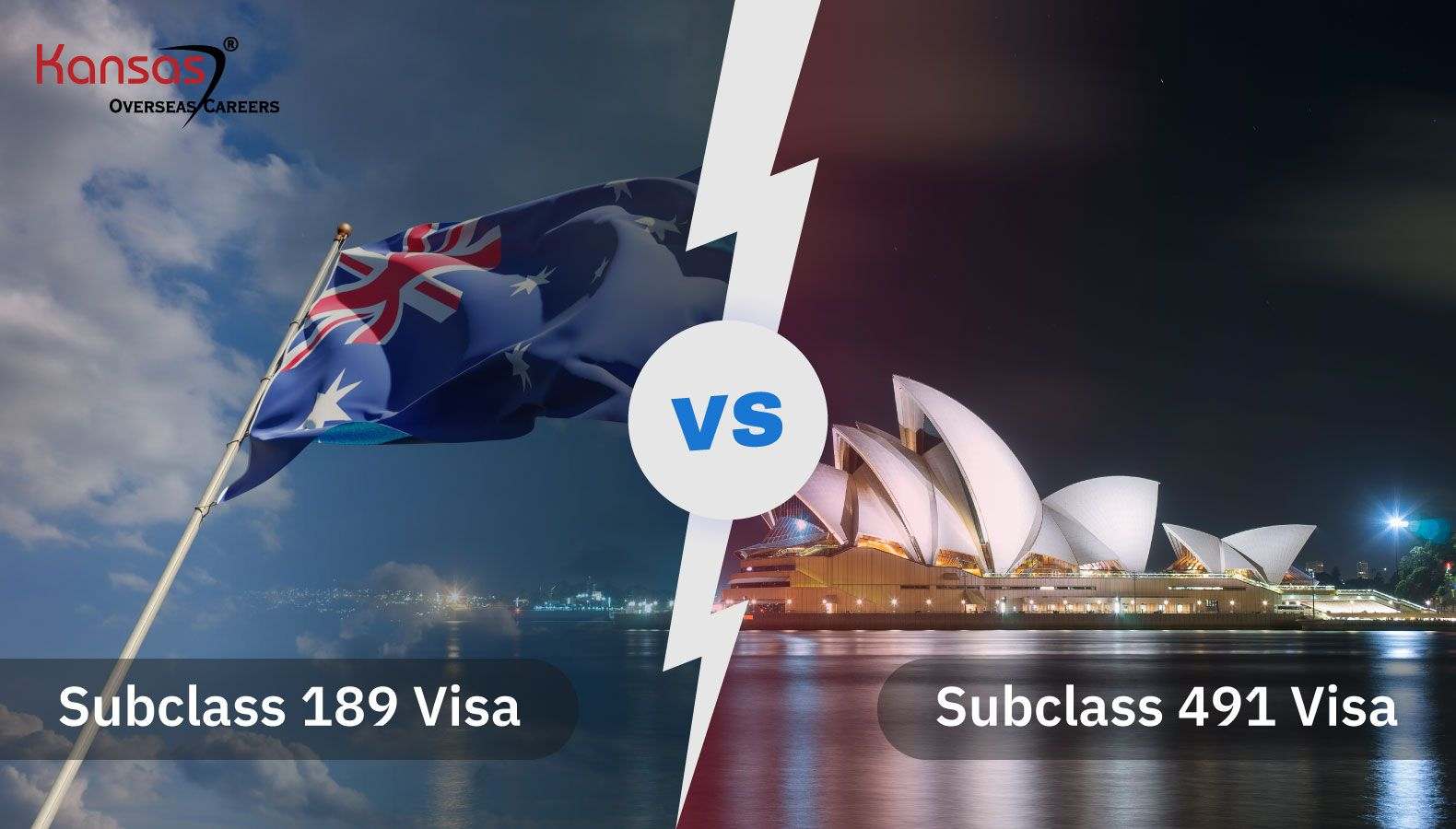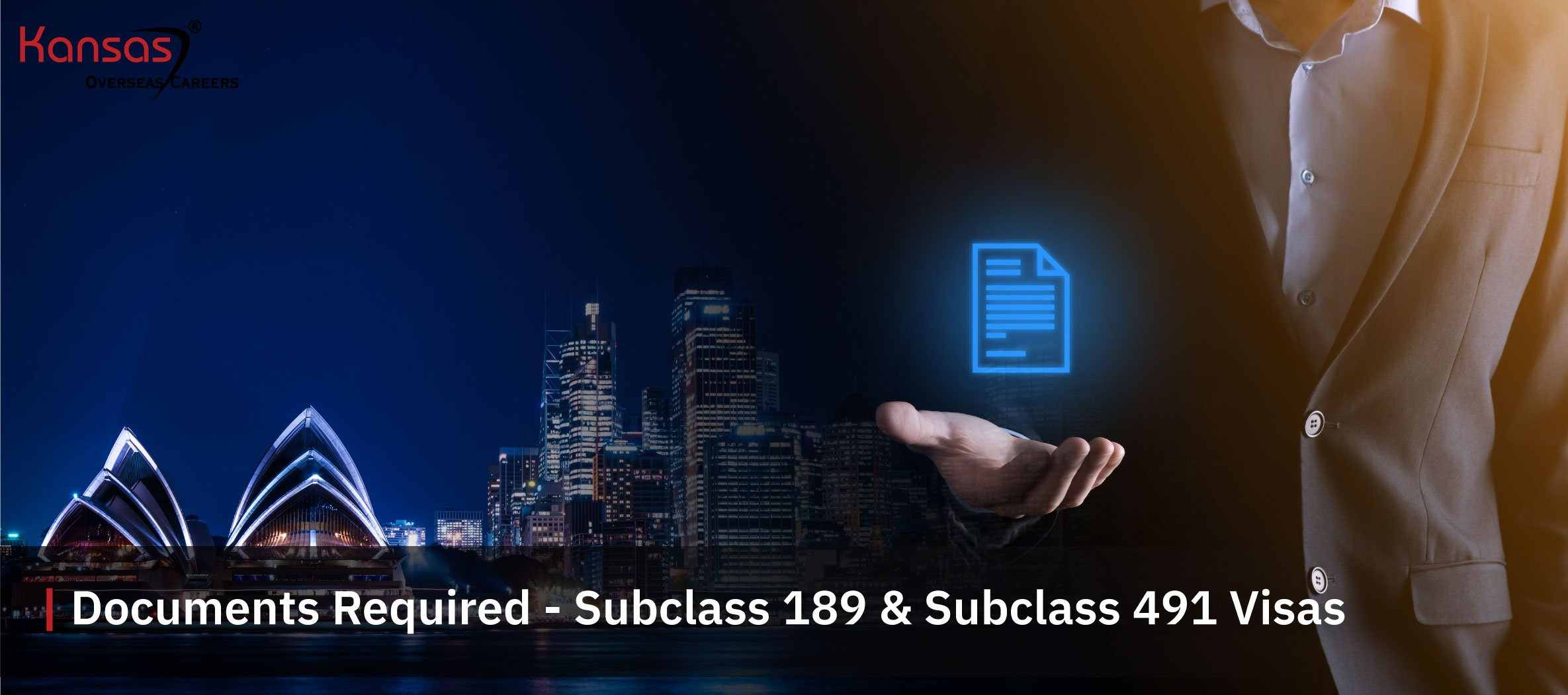Both Subclass 189 and Subclass 491 visas are pathways that allow foreign nationals to immigrate to Australia with full work rights. The Subclass 189 visa is a permanent resident work visa and is also known as Skilled Independent Work Visa. The Subclass 189 does not require sponsorship by a relative, an employer or State/Territory government in Australia.
The Subclass 491 visa is also known as the Skilled Work Regional (Provisional) visa. It allows skilled workers and their families to live, work and study in particular states of Australia for five years. Foreign workers in this category can apply for permanent residency after three years. Here’s a comparative study between Australia Subclass 189 Vs 491 visas. Read on to know requirements, benefits and costs involved.
Subclass 189 Vs 491 Visas

Both these visa pathways attract skilled workers from around the world. Both these visas fall under the General Skilled Migration (GSM) category.
- The Skilled Independent Visa (Subclass 189)
- The Skilled Work Regional (Provisional) (Subclass 491)
While the Subclass 189 visa is for permanent residency, the Subclass 491 is a transitional visa that allows permanency after 3 years.
General Skilled Migration Visas
Subclass 189 & Subclass 491 Features
|
Permanent Skilled Independent Subclass 189 Visa |
Skilled Work Regional (Provisional) Subclass 491 Visa |
|
The number of invitations depends upon places available in occupation and your points total |
An invitation is guaranteed if sponsorship is approved by the state/territory |
|
Permanent residence status |
Provisional residence status |
|
Full access to movement & other social benefits |
Candidates have to live and work in the sponsoring state |
|
Unconditional & unrestricted PR |
Can apply for PR visa after 3 years |
|
Medicare benefits |
No medicare benefits |
|
Free to work in any occupation |
Free to work in any occupation |
|
Can take your partner along |
Can take your partner along |
|
Can sponsor parents after 2 years of residence in Australia |
Can sponsor parents 2 years after gaining permanent visa in Australia |
|
It is the most competitive visa, and only certain professionals can apply. |
Visa holders have to earn a minimum of $53,900 every year. |
Requirements for Subclass 189 & Subclass 491 Visas
It is important that you ensure that you meet the requirements of the visa you are applying for.
Subclass 189 & Subclass 491 Visa Requirements
|
Permanent Skilled Independent Visa Subclass 189 Visa |
Skilled Work Regional (Provisional) Subclass 491 Visa |
|
|
|
|
|
|
|
|
|
|
|
|
Documents Needed for Subclass 189 & Subclass 491 Visas
Supporting documents play a crucial role when you are a visa applicant. You should be submitting as many documents as possible, along with your visa application. It is better to take professional help and provide complete documents as required by the Australian immigration authorities.
Note these crucial points before submitting documents.
- Documents should be scanned and uploaded with the application.
- Documents should be certified copies of original documents.
- Do not attach original documents unless asked by immigration authorities.
- Certified English translations should be attached with documents in other languages.
Documents Required with Subclass 189 & Subclass 491 Visas

Identical documents are required for both visas except for different application forms. Here is a list of documents.
- Requisite application form
- Passport with photo
- Skill assessment report
- IELTS or PTE English language test report
- Skilled employment documents
- 2 coloured passport size photographs
- Education qualification documents (including highest degree)
- Australian study requirement
- Partners’ skills
- Relationship documents
- Health documents
- Character documents
- Employment reference letters
- Any other documents asked for
Collect all the documents with the utmost care. A single mistake can hamper your chances. Make sure to double-check with the Australian immigration officials to avoid delay in processing.
Costs Involved in Subclass 189 & Subclass 491 Visas
.jpg?width=790&name=Costs-Involved-in-Subclass-189-%26-Subclass-491-Visas%20(1).jpg)
Here are the tables showing the estimated costs for both these visas.
Application Fees for Subclass 189 & Subclass 491 Visas
|
Primary Adult Applicant |
AUD 4,115 |
|
Additional Adult Applicant (above 18 years) |
AUD 2,055 |
|
Dependent Child (below 18 years) |
AUD 1,030 |
Other Expenses Associated with Subclass 189 & Subclass 491 Visas
|
Type of Fee |
Fee to be Paid per Individual |
|
Education Credentials & Work Assessment (ACS) |
USD 390 |
|
Police Clearance Certificate (varies by country) |
USD 18 |
|
English Proficiency Test |
USD 200 |
|
Medical Examination (varies by country) |
USD 350 |
Obtaining an Australian visa is a long and extensive process. The visa fees can be paid online using both debit and credit cards. However, you may have to include some additional transaction charges when you pay through cards.
Processing Times for Subclass 189 & Subclass 491 Visas
There are several aspects to processing times required for these visas. Like time taken by skill assessing authorities, state sponsorship, invitation rounds, and others. Here is a step-by-step guide to processing your Subclass 189 and Subclass 491 visas.
Guide to Processing Times for Subclass 189 & Subclass 491 Visas
|
Processing Time for 189 Visa |
Permanent Skilled Independent Visa Subclass 189 Visa |
Skilled Work Regional (Provisional) Subclass 491 Visa |
Processing Time for 491 Visa |
7 - 12 Working Days |
Check if your occupation or profile is present in the Skilled Occupation List (SOL) |
State Sponsorship Except for NSW, Victoria & Queensland presently |
8 - 12 Weeks |
|
0 - 15 days |
Ensure that you meet all eligibility requirements |
Ensure that you meet all eligibility requirements |
0 - 15 days |
|
2 - 3 Months |
Complete the Skills Assessment Tests |
Complete the Skills Assessment Tests |
2 - 3 Months |
|
15 Working Days |
Submitting an EOI through Skill Select |
Processing time for Invitations after submitting EOI |
2 months |
|
2 Months |
Filing Application for the Visa |
Filing Application for the Skilled Nomination Visa |
2 Months |
|
15 - 30 Days |
Waiting for a decision |
State or Region Nomination Application |
2 - 8 Weeks |
The total processing time for the Subclass 189 visa can take anywhere between 8 to 9 months after having submitted the Skilled Independent Visa application.
The total processing time for the Subclass 491 visa can take anywhere from 7 to 11 months after having submitted the Skilled Work Regional (Provisional) Visa application.
Other Important FAQs
Which Visa is better? Subclass 189 or Subclass 491?
The Subclass 189 visa is for permanent residency and so more preferred by immigrants. The Subclass 491 visa is a transitional visa. It only allows permanency and moving to other parts of Australia for work after 3 years.
Can I apply for a Subclass 189 visa while on Subclass 491?
No. The immigration authorities have placed restrictions on the visas you can apply for while holding 491 skilled nominated visas. This is to stop immigrants from moving to other areas after receiving the 491 visas. The 491 visa holder will not be able to apply for subclasses 189, 190, 186, 820, and many more visas.
What is the validity period for the Subclass 189 visa?
The Skilled Independent (Subclass 189) Visa validity period is indefinite. It is a permanent resident visa and includes close relations as well in the application.
Are 70 points enough for a Subclass 189 visa?
The minimum points requirement for the Subclass 189 visa at the end of the year 2019 was 90 points to secure an invitation. These candidates also had to wait for 4 months to secure an invitation.
What are the benefits of a Subclass 491 skilled visa?
The Subclass 491 provisional visa entitles the holder and the close relatives to live, work and study in the designated region of Australia. The Skilled Nominated Visa 491 also permits the nominated visa holder to travel in and out of the country multiple times during the validity period of the visa.
Are 80 points enough for a Subclass 491 skilled visa?
Yes. A minimum of 65 points is required to apply for the Subclass 491 skilled visa grant. You can submit an expression of interest if the nominated skilled occupation is in high demand within the state or regional Australia.
How can an Australian PR candidate increase his points?
There are additional ways as to how Australian PR candidates can gain more points. Some of these are listed below.
- Sit in an English language proficiency test
- Receive a nomination from a state or territory
- Partner’s skills are also helpful
- Obtain work experience in Australia
- Become an accredited translator
- STEM qualifications
How many types of general skilled migration visas are available?
The Australian government’s skilled migration program issues 3 types of visas.
- Skilled Independent Subclass 189 Visa
- Skilled Nominated Subclass 190 Visa
- Skilled Regional Nominated Subclass 491 Visa
These visas are permanent residency visas or lead to permanent residence.
What is the difference between the subclass 189 and subclass 190 visas?
Both of these subclass requirements are different. The 189 visa does not require any sponsorship, but the 190 visa requires a state or territory nomination.
What is the difference between the subclass 489 visa and subclass 491 visas?
The subclass 491 visa has replaced the subclass 489 visa from 16 November 2019. The 491 visa is a points-based visa. It also has an age limit of 45 years along with skills assessment in the nominated occupation.
How much work experience is required for an Australia PR visa?
You can apply for Australian citizenship after 3 years with the PR visa. General eligibility criteria include 8 to 10 years of work experience inside or outside Australia.
Can I study in an Australian educational institution and then apply for PR?
Foreign nationals require work experience after studying for at least 2 years in Australia. Moreover, they will have to first apply for post-study work permits before PR. Work experience in the given occupation areas has better chances of getting PR.
How valuable is a migration agent for Australia PR?
Highly valuable because they have done it hundreds of times for various clients. However, opt for a registered migration agent who is up-to-date with current laws and regulations.
Conclusion
The Australian Subclass 189 and Subclass 491 visas compare very well. But though the 189 visa is more difficult to get, it is a winner as you get permanent residency in the country at the outset. The regional 491 visas may be easier to obtain, but it is transitional, and you would have to wait for another 3 years to apply for PR.
Getting a PR in Australia is not an easy process. Recent changes have tightened the immigration policy. Studying in Australia can be a good option as the first step. Applying for permanent residency in Australia after completing studies is preferred by many students. You can also choose the occupation in-demand this way. The good news is that a Ph.D. study visa gives you direct access to permanent residency.

.jpg)







